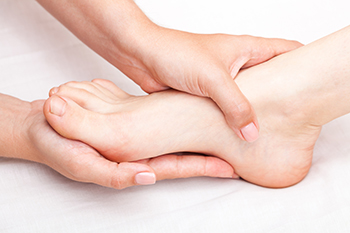Blog
Treating Toenail Fungus

Onychomycosis, also called tinea unguium, is a fungal infection affecting the nails. Fungi thrive in warm, moist environments which can cause them to overpopulate. The same fungi that cause jock itch, athlete’s foot, and ringworm can cause nail infections. Such an infection might present itself as yellow or white spots on the toenail, the nail may raise from the nail bed, the skin surrounding the affected toenail may darken, the nail can become brittle and thick, and there may be a foul odor. Complications can arise from toenail fungus, so early intervention is suggested. Toenail fungus is contagious as well. It can spread between nails, onto the skin, and to other people. If you have any of these symptoms, see a podiatrist for a proper diagnosis. Fungal infections can mimic symptoms of other conditions. Once confirmed, a podiatrist will be able to recommend treatment for your specific toenail issue.
For more information about treatment, contact one of our podiatrists of James Kutchback, DPM, CWS-P. Our doctors can provide the care you need to keep you pain-free and on your feet.
Toenail Fungus Treatment
Toenail fungus is a condition that affects many people and can be especially hard to get rid of. Fortunately, there are several methods to go about treating and avoiding it.
Antifungals & Deterrence
Oral antifungal medicine has been shown to be effective in many cases. It is important to consult with a podiatrist to determine the proper regiment for you, or potentially explore other options.
Applying foot powder on the feet and shoes helps keep the feet free of moisture and sweat.
Sandals or open toed shoes – Wearing these will allow air movement and help keep feet dry. They also expose your feet to light, which fungus cannot tolerate. Socks with moisture wicking material also help as well.
If you have any questions please contact our offices located in The Woodlands and Woodville, TX . We offer the newest diagnostic and treatment technologies for all your foot and ankle needs.
Preventing Athlete’s Foot

Athlete’s foot is a common infection that can affect a wide range of individuals. This fungal infection is caused by ringworm, and it can be spread by walking barefoot on highly trafficked public surfaces like pool sides. It is important to note that the fungus causing ringworm thrives in environments that are both warm and moist which is why athlete’s foot is often developed after walking barefoot in public locker rooms. There are several steps you can take to avoid developing athlete’s foot. First, you might consider wearing socks, shoes, or slippers when walking around the house. If a member of your household has athlete’s foot, the infection can be spread to others through bath mats, floors, and other surfaces. Second, it might be wise to wash and disinfect items that make frequent contact with the feet. Namely, you could diligently wash any towels, socks, or sheets that encountered another person’s bare feet. If you believe that you have athlete’s foot or want to learn more about methods of prevention, contact a podiatrist.
Athlete’s foot is an inconvenient condition that can be easily reduced with the proper treatment. If you have any concerns about your feet and ankles, contact one of our podiatrists from James Kutchback, DPM, CWS-P. Our doctors will treat your foot and ankle needs.
Athlete’s Foot: The Sole Story
Athlete's foot, also known as tinea pedis, can be an extremely contagious foot infection. It is commonly contracted in public changing areas and bathrooms, dormitory style living quarters, around locker rooms and public swimming pools, or anywhere your feet often come into contact with other people.
Solutions to Combat Athlete’s Foot
- Hydrate your feet by using lotion
- Exfoliate
- Buff off nails
- Use of anti-fungal products
- Examine your feet and visit your doctor if any suspicious blisters or cuts develop
Athlete’s foot can cause many irritating symptoms such as dry and flaking skin, itching, and redness. Some more severe symptoms can include bleeding and cracked skin, intense itching and burning, and even pain when walking. In the worst cases, Athlete’s foot can cause blistering as well. Speak to your podiatrist for a better understanding of the different causes of Athlete’s foot, as well as help in determining which treatment options are best for you.
If you have any questions please feel free to contact our offices located in The Woodlands and Woodville, TX . We offer the newest diagnostic and treatment technologies for all your foot and ankle needs.
Working On Your Feet While Pregnant

Many individuals throughout the American workforce spend a significant amount of the workday on their feet. For example, cooks, construction workers, and hairstylists spend most of their time on the clock standing on their feet. There are a few things to be mindful of, however, for pregnant women who hold jobs that require them to stand all day. Standing for prolonged periods while pregnant can not only be dangerous, but it can also be difficult or painful. It is recommended that pregnant women stand for no more than four or five hours while taking frequent breaks throughout the workday. Since pregnant women’s feet are prone to swelling, it is more important to listen to your body and give your feet the rest that they need. As the pregnancy progresses, a woman might notice standing becomes increasingly difficult throughout the workday. Pregnant women might choose to lie down during breaks as well as stay hydrated and elevate their feet. Working on one’s feet is certainly nothing to take lightly, particularly if you are pregnant or are planning to be. Consult with a podiatrist for the best advice on maintaining the health of your feet.
While working on the feet, it is important to take the proper care of them. For more information about working on your feet, contact one of our podiatrists from James Kutchback, DPM, CWS-P. Our doctors will treat your foot and ankle needs.
Working on Your Feet
Standing on your feet for long periods of time can cause stress and pain in your feet. Your whole body may experience change in terms of posture, back pain, bunions, callouses and or plantar warts. There are ways to avoid these conditions with proper foot care, smart choices and correct posture.
Positive Changes
Negative heeled shoe – Choosing this shoe type places the heel slightly lower than the ball of the foot. These are great for overall foot health. Find shoes that fit you correctly.
Go barefoot – Our feet were not designed to be enclosed for all hours of the day. Try to periodically expose your feet to air.
Eliminate Pain
Foot Exercises – Performing simple exercises, incorporating yoga and doing stretches are beneficial. This will allow increased blood flow to the area and muscles of the foot.
Achilles tendon – Stretching the foot out flat on the floor will relax the calf muscles and tendon. These exercises can be performed almost anywhere. Make sure you add these exercises to your daily regimen.
With a little bit of this information and knowing more about foot health, you will notice changes. Foot stretches and proper footwear will help with pain and prevent further issues.
If you have any questions please contact our offices located in The Woodlands and Woodville, TX . We offer the newest diagnostic and treatment technologies for all your foot and ankle needs.
What Is a Plantar Fibroma?

If you notice a bump on the arch of your foot, it may be a plantar fibroma. It is defined as a benign growth that develops in the plantar fascia, which is the band of tissue on the sole of the foot. Its function is to connect the toes to the heels, and contributes to stabilizing the arch. A plantar fibroma can gradually increase in size, and can be present on one or both feet. It may begin as a lesion, and can lead to plantar fibromatosis, which is also known as Ledderhose disease. The common symptoms that many patients experience can be painless bumps in the beginning stages on the arch of the foot, and may eventually become worse if left untreated. It may be uncomfortable to walk or stand for an extended period of time, and wearing shoes may cause friction. Research has indicated it may be unknown why a plantar fibroma may develop, despite possibly being connected to specific medical conditions. These include diabetes, liver disease, or epilepsy. There are several treatment options for this ailment, and it is strongly suggested that you schedule an appointment with a podiatrist who can help you with a plantar fibroma.
A plantar fibroma may disrupt your daily activities. If you have any concerns, contact one of our podiatrists of James Kutchback, DPM, CWS-P. Our doctors can provide the care you need to keep you pain-free and on your feet.
Plantar Fibroma
A plantar fibroma is a fibrous knot in the arch of the foot. It is embedded in the plantar fascia which is a band of tissue that extends from the heel to the toes along the bottom of the foot. There can be multiple plantar fibromas in the feet at the same time. There are no known causes for this condition. If you have a plantar fibroma, there will be a bump in the arch of your foot that cannot be missed. Any associated pain is most often due to a shoe rubbing against the nodule. Non-surgical options, such as steroid injections, physical therapy, and orthotics should be tried first. Surgery is a last resort and is the only thing that will remove a plantar fibroma entirely. Consult with a podiatrist for a proper diagnosis and to determine the treatment regimen that is right for you.
What Causes a Plantar Fibroma?
While there are no specific causes identified, a plantar fibroma can possibly come from genetic predisposition or the formation of scar tissue that forms from healing the tears in the plantar fascia.
What Are the Symptoms of a Plantar Fibroma?
There will be a noticeable lump in the arch of the foot that may or may not cause pain. If pain is felt, it is typically because a shoe is rubbing up against the lump or when walking or standing barefoot.
Treatment and Prevention
A plantar fibroma will not disappear without treatment, but it can get smaller and be a non-issue. If pain persists, a podiatrist examines the foot and when the arch of the foot is pressed, pain can be felt down to the toes. An MRI or biopsy might be performed to help diagnose or evaluate the plantar fibroma. The following non-surgical options are generally enough to reduce the size and pain of these nodules:
- Steroid injections
- Orthotics
- Physical therapy to help apply anti-inflammatory creams on the bump
Surgery is considered if the mass increases in size and the patient continues to feel pain after non-surgical methods are tried.
If you have any questions, please feel free to contact our offices located in The Woodlands and Woodville, TX . We offer the newest diagnostic and treatment technologies for all your foot care needs.
Am I a Candidate for Foot Surgery?

Many people undergo foot surgeries when all other options for have failed. There are several types of foot surgery, which can be successful for permanent relief. An Achilles tendon rupture may require surgery, and this is accomplished by having a 3-inch incision cut at the back of the ankle where the tendon has ruptured. The tendon is sewn together with sutures. After closing the wound, the foot is typically placed in a protective boot as the healing process occurs. Bunion surgery is another common form of foot surgery. A bunion is a bony protrusion of the big toe that can develop from genetic factors or wearing shoes that are too tight. If the bunion becomes painful and completing daily activities becomes difficult, joint fusion may be a viable option. It is done by fusing the joint of the big toe. Another alternative may be to have a joint replacement performed. If you are considering any type of foot surgery, it is strongly advised that you are under the care of a podiatrist who can determine if you are a candidate.
Foot surgery is sometimes necessary to treat a foot ailment. To learn more, contact one of our podiatrists of James Kutchback, DPM, CWS-P. Our doctors will assist you with all of your foot and ankle needs.
When Is Surgery Necessary?
Foot and ankle surgery is generally reserved for cases in which less invasive, conservative procedures have failed to alleviate the problem. Some of the cases in which surgery may be necessary include:
- Removing foot deformities like bunions and bone spurs
- Severe arthritis that has caused bone issues
- Cosmetic reconstruction
What Types of Surgery Are There?
The type of surgery you receive will depend on the nature of the problem you have. Some of the possible surgeries include:
- Bunionectomy for painful bunions
- Surgical fusion for realignment of bones
- Neuropathy decompression surgery to treat nerve damage
Benefits of Surgery
Although surgery is usually a last resort, it can provide more complete pain relief compared to non-surgical methods and may allow you to finally resume full activity.
Surgical techniques have also become increasingly sophisticated. Techniques like endoscopic surgery allow for smaller incisions and faster recovery times.
If you have any questions, please feel free to contact our offices located in The Woodlands and Woodville, TX . We offer the newest diagnostic and treatment technologies for all your foot care needs.
Out-Toeing or Duck-Footedness in Children

As toddlers are learning to walk, their gait may be characterized as duck-footed, or out-toeing. This happens when they walk with their toes pointing outward rather than forward. In many children, this way of walking is temporary. A child will often outgrow this by age six to eight years of age. However, sometimes it can persist into adolescence, or even adulthood, and can lead to more serious complications. Out-toeing is a type of torsional deformity and usually occurs when one of the leg’s two longest bones (the tibia, located between the knee and ankle, and the femur, located between the hip and knee) turn towards the outside of the leg, causing the foot to jut out. This condition can occur in one or both legs. Most often, the child does not experience pain or discomfort with this condition, and it does not affect their mobility. Parents might see that their kid’s shoes wear out or have more obvious scuff marks on the outer edges of the shoes if the child is duck-footed. Causes of out-toeing include genetics, fetal position of the legs in the uterus prior to birth, the resting position of the legs during infancy, and being flat-footed. Rarer reasons for this condition are congenital bone deformity or a hip condition, called slipped capital femoral epiphysis, that causes the ball at the top of the femur to slip backwards. If you are concerned about your child’s gait or you notice that they are experiencing pain, imbalance, or instability when walking, see a podiatrist who can alleviate your concerns or provide treatment options to consider.
Making sure that your children maintain good foot health is very important as they grow. If you have any questions, contact one of our podiatrists of James Kutchback, DPM, CWS-P. Our doctors can provide the care you need to keep you pain-free and on your feet.
Keeping Children's Feet Healthy
Having healthy feet during childhood can help prevent medical problems later in life, namely in the back and legs. As children grow, their feet require different types of care. Here are some things to consider...
Although babies do not walk yet, it is still very important to take care of their feet.
Avoid putting tight shoes or socks on his or her feet.
Allow the baby to stretch and kick his or her feet to feel comfortable.
As a toddler, kids are now on the move and begin to develop differently. At this age, toddlers are getting a feel for walking, so don’t be alarmed if your toddler is unsteady or ‘walks funny’.
As your child gets older, it is important to teach them how to take care of their feet.
Show them proper hygiene to prevent infections such as fungus.
Be watchful for any pain or injury.
Have all injuries checked by a doctor as soon as possible.
Comfortable, protective shoes should always be worn, especially at play.
If you have any questions, please feel free to contact our offices located in The Woodlands and Woodville, TX . We offer the newest diagnostic and treatment technologies for all your foot care needs.
Freiberg’s Disease

Freiberg’s disease, also known as Freiberg’s infarction or Frieberg's infraction, is associated with pain in the forefoot. It has to do with the softening of one of the metatarsal heads and typically occurs in teenagers that are growing. If excessive weight is put on this part of the foot, it can lead to a microfracture of the metatarsal head. Symptoms are swelling and discomfort at the ball of the foot and the joint associated with the affected toe – usually the base of the second toe. It is common for one with this affliction to have a long second toe that sustains repetitive force. A person with Freiberg’s disease might limp during the acute phase of the condition and it can become chronic before it is diagnosed. An X-ray or MRI can be used to help diagnose this disease and it is often treated non-invasively, with proper fitting shoes with a wide toe box and metatarsal pads to offset the pressure on the area. Sometimes a walker boot, cast, and/or anti-inflammatory medication is needed to offset weight bearing. There can be a residual deformity of the joint and discomfort that remains over time. However, rarely is surgery done to clean out the joint or shorten the metatarsal. If you/your child is experiencing pain and swelling near the ball of the foot, it is suggested you consult with a podiatrist who can take proper measures to detect the problem and treat it.
Some foot conditions may require additional professional care. If you have any concerns, contact one of our podiatrists of James Kutchback, DPM, CWS-P. Our doctors can provide the care you need to keep you pain-free and on your feet.
Rare Foot Conditions
The majority of foot conditions are common and can be treated by a podiatrist. Standard diagnostic procedures are generally used to identify specific conditions and treatment can be rendered. A podiatrist also treats rare foot conditions which can be difficult to diagnose and may need extra attention and care.
There are many rare foot conditions that can affect children. Some of these can include:
- Freiberg’s disease
- Kohler’s disease
- Maffucci syndrome
Freiberg’s disease - This can be seen as a deterioration and flattening of a metatarsal bone that exists in the ball of the foot. It typically affects pre-teen and teenage girls, but can affect anyone at any age. Symptoms that can accompany this can be swelling, stiffness, and the patient may limp.
Kohler’s disease - This often targets the bone in the arch of the foot and affects younger boys. It can lead to an interruption of the blood supply which ultimately can lead to bone deterioration. The patient may limp or experience tenderness, swelling, and redness.
Maffucci syndrome - This affects the long bones in a child’s foot leading to the development of abnormal bone lesions. They are benign growths and typically develop in early childhood and the bones may be susceptible to breaking.
A podiatrist can properly diagnose and treat all types of rare foot conditions. If your child is affected by any of these symptoms or conditions, please don’t hesitate to call our office so the correct treatment method can begin.
If you have any questions, please feel free to contact our offices located in The Woodlands and Woodville, TX . We offer the newest diagnostic and treatment technologies for all your foot care needs.






